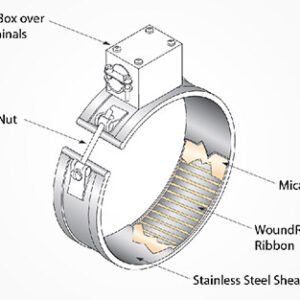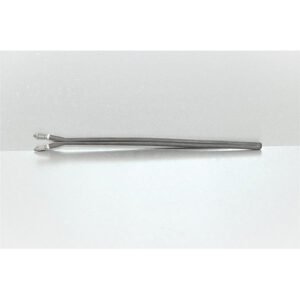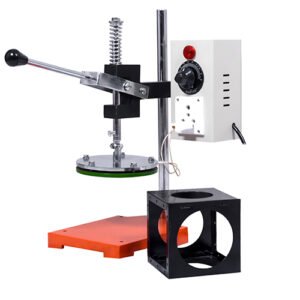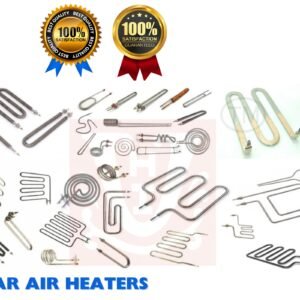- Description
Description
Short wave quartz infrared heaters are used in various industrial applications. It contains tungsten filament, helically wound, encased in quartz envelope. Tungsten as resistive element is capable of generating temperature in excess of 2750° C. Its response time is very rapid in 1 second it emits over 90% of IR energy. It is by products free & pollution free. Heat focus is very accurate due to compact and narrow diameter of IR tubes. Short wave IR element has maximum heating rate of 200W/inch.
The quartz envelope allows transmission of IR energy and protecting the filament from convective cooling and corrosion. Addition of small percentage of halogen gas in it not only increases life of emitter but also protects blackening of tube and depreciation on infrared energy. The rated life of short wave infrared heater is around 5000 Hrs

Short Wave Infrared Heater transmits heat in the form of electromagnetic waves at a velocity of approximately 3,00,000 Km/Sec i.e., at the speed of light.
These lamps are not only the fastest in transmitting heat but are most suitable for specific applications involving vacuum technology and dust free (clean room) conditions.
Infrared heat is particularly economical on energy compared to other heat sources because it acts quickly, directly on products. Short Wave Infrared heaters are suitable for all applications in which the attainment of high temperatures in the shortest possible time is what counts.
FEATURES
- Shortwave Infrared Heater is a high efficiency heating radiator that can heat up to 900 °C and cool down in seconds. It is made of high purity of quartz tube and Tungsten wire, filling with halogen gases inside the tube to protect tungsten wire and avoid filament oxidation when working
- The emitted radiation of the lamps is much more effective than other heat transmission methods such as convection or conduction heating. Objects or their surfaces can be heated up from rather distant light source even through a glass window. Instant Radiation from the Lamp allows Fast & Flexible Thermal Processes
- The color temperature of shortwave quartz infrared heater is around 2400 to 2500°K.The IR wavelength of the of the Shortwave Infrared Heaters radiation emission is between 1 to 2 μ
- Available in different variations from customized Heating Lengths, Power, End Connections, Reflector Coatings and Shapes as well

Shortwave Infrared Heaters - Off Condition

Shortwave Infrared Heaters - On Condition
- Plastics
- PET preform heating in Stretch blow moulding machines
- Powder coating curing
- Resins Hardening, Rubber coating drying
- Adhesives – End polymerization
- Food – Pasteurization / Sterilization
- Paper Industry – Humidity Control
- Industrial Drying – Paint , Varnishes , Dyeing
- Semi Conductor Industries – Heating of wafers
- Printing – Printing ink drying in screen and offset machines
Some of the most common factors that lead to premature shortwave quartz halogen lamp failure are as follows
- Improper storage of stocked lamps: One of the most common sources of breakage is – annoyingly – one of the most basic. Quartz lamps have very thin walls and hence are very fragile, so lamps should always be stored in their shipping containers to prevent breakage and contamination. There is nothing more frustrating than going to the shelf for an emergency replacement lamp only to find that the stocked lamps are broken
- Improper installation: When installing the lamps, extreme caution should be used. The lamps should not be “forced” into position or into clamps. This is especially true of longer lamps. Forcing can induce micro cracks in the quartz which may go unnoticed, but can eventually result in premature lamp failure.
- Devitrification due to contamination: Oils, salts and other contaminates cause devitrification of the quartz tube, a process where crystalline structures grow on or within the surface of the quartz. Devitrification causes the quartz to become opaque to infrared energy, rather than being transparent. This traps excess energy within the quartz, causing the filament to overheat and resulting in lamp failure. The oils and salts from handling with bare hands, shop oils, and dust are all common sources of infrared lamp devitrification. Before being installed and powered up, all quartz halogen lamps should be visually inspected, and wiped clean using denatured alcohol. When handling quartz tube halogen lamps, you should always wear cotton gloves
- Improper powering up: When powering up your IR lamps, a Soft Start Silicon Controlled Rectifier (SCR) should be used. Minimizing temperature extremes results in less expansion and contraction of the filament and extends lamp life. Full power causes a very high in-rush current, possibly damaging the wiring and blowing fuses. A Soft Start SCR ramps up the lamp voltage in predetermined steps bringing the filament temperature up incrementally, and avoiding any potential damage to the filament
- Improper power connections: Our final reason is another easily-avoidable one. IR lamps like all electrical products must be properly connected to the power. Loose connections and undersized wires are common reasons for a quartz halogen lamp’s shortened life. Being vigilant during setup, and creating a system of periodic checks are good ways to avoid losing a lamp due to an improper connection

























